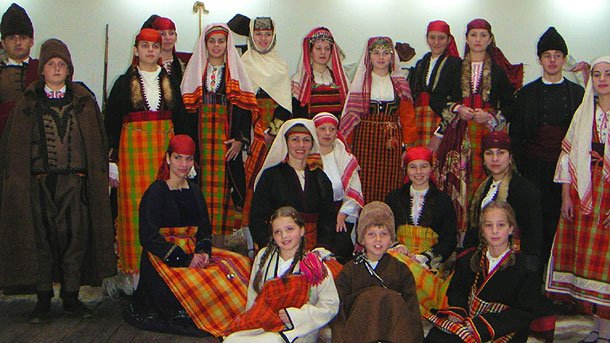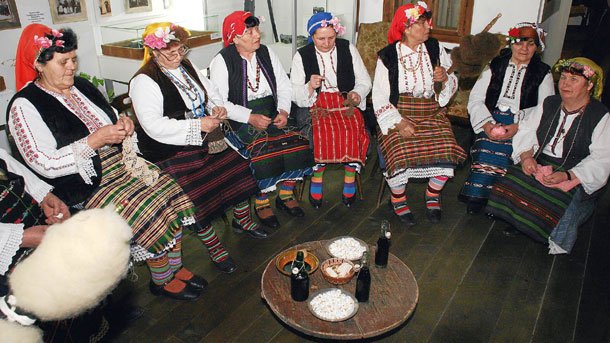In the traditional Bulgarian culture women used wool, cotton and silk to make clothes and various household objects. They also used flax and hemp. In most cases they bred and grew the livestock and the plants for basic raw materials. The quality of textiles was important not simply for these fabrics' place and function in people's lives. They were often bestowed magical qualities.

© Photo: archive
The festive traditional costumes of Bulgarians offer a lavish wealth of colors, embroidery, ornaments and models. Every folklore region had its quite unique folk costumes. Along with local dialects and folk music, costume designs were part of the specifics of traditional culture in various region. What costumes from various regions of Bulgaria share is fabrics. Both men and women wore white shirts under their upper clothes – made predominantly of cotton, and sometimes of silk, for more festive occasions. In some places, the sleeves alone were made of silk. Silk-worm breeding was well-developed in certain regions, and the raw material obtained was expensive, just like today. Dyed silk fibers were widely used for sophisticated embroideries that decorated the necklines and sleeves of female shirts, and of the wedding garments. In the traditional Bulgarian notions, silk was a clear sign of material wealth. Carol singers on Xmas wished to the community “A house full of silk” along with the blessings for fertility of the fields, for health and new offspring in households. Ritual sieves were silk too. They were used to sieve three times the flour for the ritual loaves of bread. The white shirts of the great heroes were made of silk too, as well as the wonder-working shirt that according to one legend, the Holy Virgin gave to a young girl.
Cotton and wool were present in rituals linked to the new beginning – the wedding, and the introduction of the young girl to female work routines. Either raw or processed, they had magical powers to cleanse. The red woolen thread was the most common means for banishing all forces of evil including evil eyes, mythical creatures, disease etc. In the traditional culture wool and cotton bring luck as well. In the past, a special ritual called sarandisvane was held on the 40th day after the birth of a baby. It is the analogue of the so-called clean prayer read out on the same day. Close relatives of the infant and the mother would visit their home bringing with them soap, cotton, wool and cloths. In case the baby was a girl, the mother symbolically gave to the midwife some tow, for the sake of the girl’s thick and healthy hair. After the 40th day after birth the risky period was over. The objects arranged around the young mother and the baby meant to protect them from evil spells, would be removed. Now the young mother could join the household routine again.
In the World Tree myth, the symbol of organized space, wool was positioned at the tree’s roots. Wool is associated with the earth and with the underground world. It is where its power to promote fertility comes from, and it is necessarily associated with the feminine quality and with offspring. Wool’s role in the wedding rituals has precisely this meaning. In the traditional culture the circle of ritual figures for the wedding travelling to take away the bride always included a woman who spins. She would not stop spinning until the young bride finally entered her new home and family. And the thread that she was winding on the spindle carried a symbolic message for a long life sheltered from evil. In some regions of Bulgaria there is a ritual spinning of a woolen thread performed by the bride and the bridegroom at the latter’s home. And her brother-in-law should give her a distaff that he had made especially for her. In other regions the bride was given a sliver of wool that she should raise three times up to the door’s upper threshold. In the southern Rhodope Mountains the newlyweds go round the table on the right stepping on white wool or are wed having stepped on white wool.

© Photo: archive
The skills of a young woman in spinning and weaving, and in knitting and sowing represented an integral part of her merits as a good and loving housewife, and a caring mother. The training of young girls and their introduction to women’s labor began at a very early age. The way the father was obliged to instruct his sons for all male tasks and chores, the mother had to see that her daughters would be fluent in the methods of processing cloth, of dress-making etc. There was an exclusively female ritual. Early in the morning, on a Monday, the girl’s mother gave to the girl a sliver of white wool tied to the distaff with a red thread. By sunset the girl had to spin the whole sliver. The mother would throw the first thread into water: „Let the girl spin as fast as the river flows!” This ritual actually gave the start to the training itself, step by step.
Researchers contend that flax was the semantic antipode of wool. It is often hymned in folk songs though in daily motions it was often replaced with hemp. Songs suggest the connection of flax with the celestial world. „Flax was perceived as one of the clean plants containing divine power arising from its ability to self-reproduce from seeds. At a symbolical level flax was an expression of the eternal cycle of life based on resurrection after death”, writes ethnologist Krassimira Krastanova. Flax was used in a range of rituals, similar to cotton. In the regions where those plants were grown seeds for sowing were blessed on Christmas Eve together with ritual food and objects.
Translated by Daniela Konstantinova
A three-day embroidery festival takes place in the square of the village of Vardim near Svishtov, the organizers reported. At its core, the festival promotes a particularly colorful part of our lifestyle and traditions -..
Fans of Bulgarian folklore are getting together in the village of Ribaritsa near Teteven on 20 and 21 July for the 3 rd national festival and the 16 th edition of the festival of folklore of national customs and authentic traditional costumes in a..
Nearly 340 participants from countries on different continents will take the stage at the Summer Theatre in Marno Pole Park in Veliko Tarnovo to present the their folklore traditions. The start is today, 20 July, when the traditional..

+359 2 9336 661
